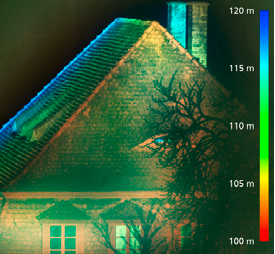LiDAR – a wide range of research for varied applications
LiDAR (Light Detection and Ranging) is a laser-based process for measuring distances and speeds. The systems in question measure the time that the light emitted from a laser needs to be reflected by an object and be detected using a sensor. LiDAR technology plays a key role particularly in the area of autonomous mobility. The measurements can be used as the basis for, say, allowing an autonomous vehicle to move safely through its environment.
For each individual component of a LiDAR system, there is a varied spectrum of research and development activities within the Research Fab Microelectronics. The scientists there are continuously advancing the laser sources, sending optics, and beam steering systems as well as receiving optics and detectors. This is because the demands on the systems are increasing – for example due to longer ranges, growing cost pressures, and new fields of application. Research is currently focused on pulsed laser diodes in the nanosecond range, powerful micromirrors, and highly sensitive detector arrays (SPADs, APDs, and SiPMs).
LiDAR technology is being advanced with industrial partners. The research know-how can thus be tailored to the individual applications and the resulting system specifications.
Last modified:
